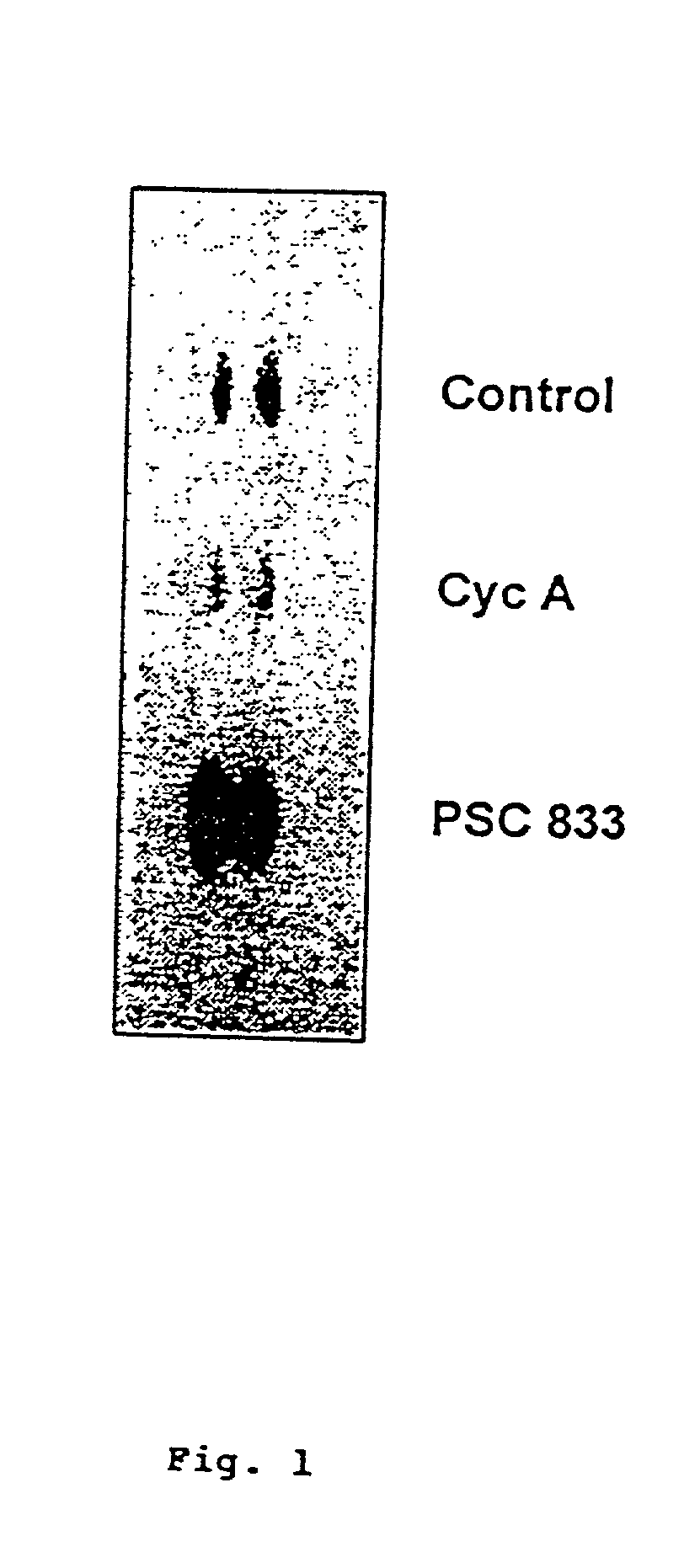Methods for screening therapeutically effective agents
a technology of therapeutic agents and screening methods, applied in the field of screening therapeutically effective agents, can solve the problems of difficult screening of agents based on their apoptotic modulating activity, frequent ineffective chemotherapy, interference with binding and export of anticancer agents to the drug pump, etc., and achieve the effect of facilitating the selection of chemotherapeutic agents
- Summary
- Abstract
- Description
- Claims
- Application Information
AI Technical Summary
Benefits of technology
Problems solved by technology
Method used
Image
Examples
example 1
6.13.2. Example 1
Effect of PSC 833 and Cyclosporine A on Glycolipid Metabolism
[0158] The effects of cyclosporine A and PSC 833 on glucosylceramide levels in MDR breast cancer cells were analyzed. The TLC autoradiograph in FIG. 1 illustrates the influence of the two cyclosporine-derived MDR modulators on glycolipid metabolism. MCF-7-AdrR cells (10 cm dishes) were grown overnight in medium containing [.sup.3H]serine (2.0 .mu.Ci / ml 5% FBS medium) and either cyclosporine A (5.0 .mu.M) or PSC 833 (2.5 .mu.M). Lipids were extracted and analyzed by TLC autoradiography as described in the Methods section. The solvent system used was chloroform / methanol / ammo-nium hydroxide (80:20:2, v / v / v). Glucosylceramide, which migrates as a doublet on TLC (due to chemical diversity of the ceramide moiety), was nearly depleted in cells that were exposed to cyclosporine A; however, upon exposure to PSC 833 glucosylceramide levels increased markedly (FIG. 1). The opposing effects of these agents on glycolip...
example 2
6.13.3. Example 2
Effect of PSC 833 on Adriamycin Efficacy in MDR Breast Cancer Cells
[0160] Comparing drug sensitive (wild-type, wt) with MDR cells, the data of FIG. 5 show that MDR cells are more resistant to PSC 833 toxicity. MCF-7-wt (wt, chemosensitive) and MCF-7AdrR cells were seeded into 96-well plates, 2,000 cells / well, and treated the following day with PSC 833 at concentrations of 0.1-10 .mu.M. Four days later cell survival was measured using the Promega cell proliferation assay as described in the Methods section. Each point represents the average of six replicate assays. At higher concentrations (10 .mu.M), MDR cell survival was only lowered by 35%, whereas wt cells were more sensitive (80% reduction in cell survival). Assessing the MDR modulatory action of PSC 833, when given at low dose (0.5 .mu.M) in combination with adriamycin, MDR cell survival was greatly reduced (FIG. 6). MCF-7-AdrR cells were seeded into 96-well plates (2,500 cells / well) and treated 24 h later with...
example 3
6.13.4. Example 3
Combination Therapy of PSC 833 with Adriamycin and Tamoxifen
[0161] The data of FIG. 7 reveal that combination therapeutics have a marked impact on ceramide production. MCF-7-AdrR cells were seeded into 6-well plates and at 60-70% confluence, cells were treated with vehicle (control), adriamycin (2.5 EM), PSC 833 (5.0 .mu.M), tamoxifen (5.0 .mu.M) or combinations indicated for 24 h in the presence of [.sup.3H]palmitic acid (1.0 .mu.Ci / ml culture medium). Lipids were extracted and ceramide was analyzed by TLC in a solvent system containing chloroform / acetic acid (90:10, v / v) followed by LSC for tritium quantitation. Data points represent the average of triplicate experiments. FIG. 7 illustrates that cells exposed to adriamycin alone, ceramide formation was not influenced. PSC 833 caused a 4.8-fold increase in ceramide levels, and tamoxifen, by itself, caused a moderate 0.3-fold increase in ceramide. When adriamycin and PSC 833 were co-administered, ceramide levels ros...
PUM
| Property | Measurement | Unit |
|---|---|---|
| concentration | aaaaa | aaaaa |
| volume | aaaaa | aaaaa |
| pH | aaaaa | aaaaa |
Abstract
Description
Claims
Application Information
 Login to View More
Login to View More - R&D
- Intellectual Property
- Life Sciences
- Materials
- Tech Scout
- Unparalleled Data Quality
- Higher Quality Content
- 60% Fewer Hallucinations
Browse by: Latest US Patents, China's latest patents, Technical Efficacy Thesaurus, Application Domain, Technology Topic, Popular Technical Reports.
© 2025 PatSnap. All rights reserved.Legal|Privacy policy|Modern Slavery Act Transparency Statement|Sitemap|About US| Contact US: help@patsnap.com



